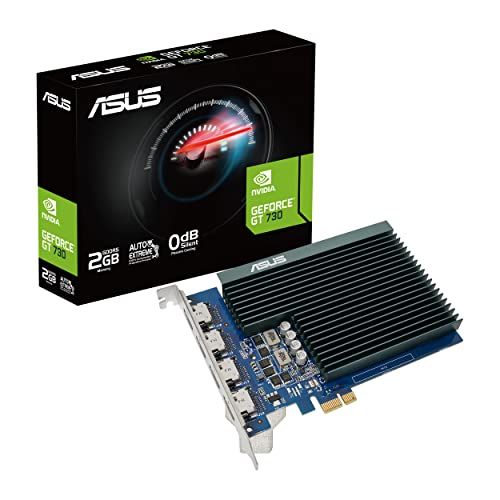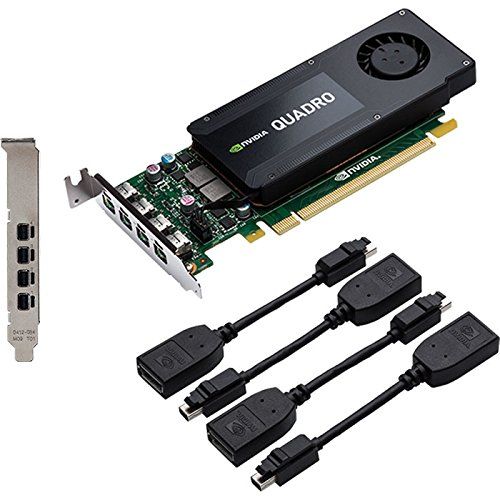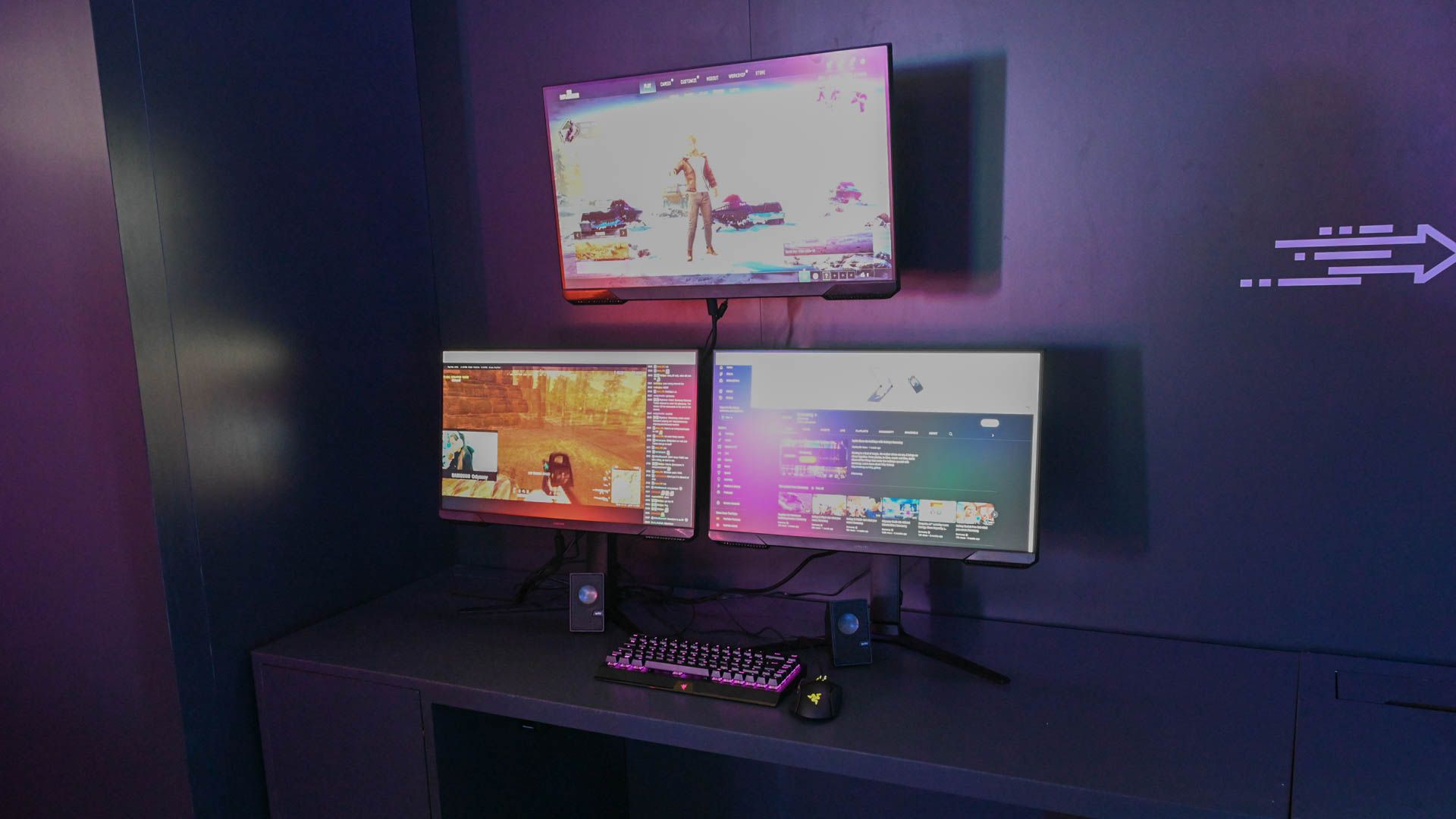Quick Links
Key Takeaways
It doesn't take a lot of processing power to drive multiple displays, so there is no need to buy a premium GPU if you simply want more monitors.
Don't let the high cost of premium GPUs stand between you and your multi-monitor dreams. Here's what you need to know about using multiple monitors for productivity without breaking the bank.
Casual Browsing and Office Work Are Low Demand
If you want to go fast, you need a car with a big engine. If you want to hold a lot of stuff, you need a vehicle, like a truck or van, with a lot of cargo space. When it comes to spreading your work over multiple monitors, there isn't much demand in the go-fast department---unless your work happens to be video rendering or other GPU-intensive activities.
Instead, what matters is the hold-a-lot-of-stuff factor. In the GPU world, that translates to how many screens the GPU can support to help you live your best multi-monitor life. For tasks like conducting research, throwing up a chat window on a side monitor while playing a casual game, or keeping an eye on multiple documents, sites, or spreadsheets at once, you don't need a lot of power.
In fact, you barely need any power at all. The processing power required to put up basic productivity and casual browsing content on two, three, or even a half dozen monitors is trivial.
And if you're worried that opting for a lower-power GPU will limit your gaming options, it might be time to take an honest assessment of your gaming habits first. If you're not chasing benchmarks in current AAA-level titles, you'll be fine with an older card. If your favorite games run fine on a laptop, they'll run fine on an older or lower-power dedicated desktop GPU.
These Cheaps GPUs Are Great for Multimonitor Setups
You can take two approaches to meeting your multi-monitor needs on the cheap. First, you can buy an older GPU. Second, you can buy a current but not top-tier GPU. There are benefits (and downsides) to both approaches.
Before we dig in, however, let's be clear. Whatever old or new GPU you have on hand that gets the job done is good enough when it comes to powering multiple displays. Because we're not trying to achieve a certain level of frame per second in a demanding game, as long as the GPU can drive the number of displays you need (be it just an extra second monitor or five more), and without any lag or screen tearing, then you're good.
Older Used GPUs Are Dirt Cheap But Dated
The best thing older GPUs have going for them is cost. You can buy a used GPU like a GTX 700 or 600-era card for next to nothing.
As of this article in January 2023, there are piles of old GTX 650 cards on eBay for as low as $20-30. You can even find GTX 750 Ti cards for under $50.
Of course, there are a few downsides to going with dirt-cheap older GPUs. An old GPU off eBay doesn't come with a warranty, and the product is already likely completely out of the manufacturer's support life cycle. You won't have any problem finding drivers for it, but if there are any updates, it will be a bug fix here or there (if there are any updates at all).
And, perhaps more pressing of an issue depending on how new your monitors are and how much fussing you want to do, you'll find old cards have outdated port configurations.
It's very common for cards old enough to have bargain-basement prices now to have port combinations like one HDMI port with a DVI and VGA port, or even just a VGA port and a DVI port. You'll also notice we didn't rattle off any 4-port combinations. Four display connections on older cards was pretty uncommon.
Using a DVI port today isn't the end of the world, but VGA is analog and pretty well antiquated at this point. So antiquated there is a good chance that if you purchased your monitor within the last few years it doesn't even have a VGA port anymore.
Most monitors are now HDMI and DisplayPort only, so consider the necessity of purchasing DVI to HDMI cables or other convertors when shopping for an old card. Sure, a quality DVI-to-HDMI cable is only about $8-10 but if you end up needing a few that bargain $50 card is now $80. Which is a perfect price point to segue into talking about buying a new card.
Updated GPUs Have Better Port Options But Cost More
Because we're not chasing gaming benchmarks, we can buy a new card without breaking the bank. The best thing new GPUs have going for them besides lower price? Modernized port configurations.
The cheapest way to get a better experience is to opt for an old-tech-new-design GPU. You can purchase a new GPU that is actually a repacked older-generation GPU technology polished up with better ports and a warranty.
A great example of this is the ASUS GeForce GT 730. The underlying card tech, the GT 730 chipset, was released way back in June 2014.

ASUS NVIDIA GeForce GT 730
The chipset might be older, but benchmarks don't matter much when you're just trying to serve up pages and documents for work.
But ASUS redesigned the card for passive cooling and slapped 4 HDMI ports on. It'll run you $80-90, which is what you'd pay on the high end for a used older card. On the upside, it's cheap and silent. On the downside, old tech is old tech, and despite the repackage and the warranty, you run into the same driver issue.
You can also pick up cards that are designed specifically for workstations (and not for gaming). The NVIDIA Quadro line is designed to serve up 4 displays at up to 4K resolution with enhancements focused on workplace demands and not on gaming performance.

PNY NVidia Quadro K1200
NVIDIA Quadro cards are designed specifically for the needs and demands of a workstation power user.
You'll spend $200-220, but it's still less than buying a used or new higher-end GPU. And, better yet, you'll save money over time because the power demands of modest multi-monitor workstation cards are much lower than those of gaming cards. (Though do note there is a class of workstation cards that are beefy and power-hungry just like their gaming counterparts.)
At the end of the day you can throw practically any compatible card with enough ports in your PC and get multi-monitor support. But opting for a used older card or a new card designed specifically for a multi-monitor will be the most economical way to get the job done.

